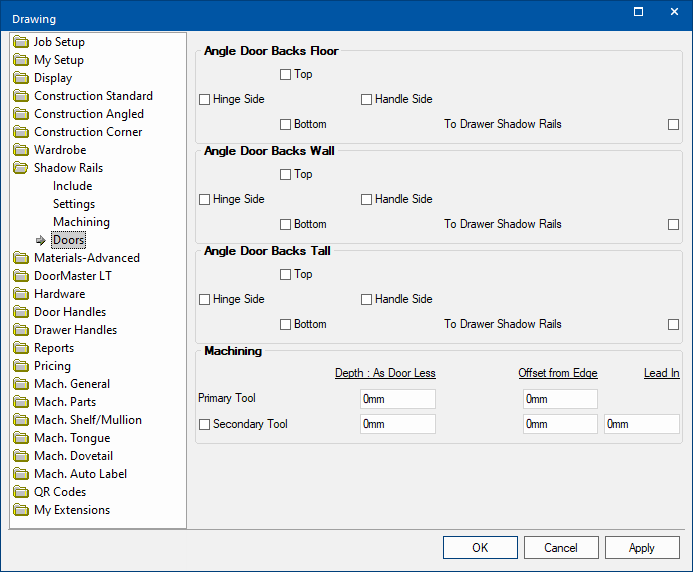

The ability to angle (or shape) a back edge of a door/drawer front to create a grab handle is often (but not always) used in conjunction with the use of Shadow Rails. The Shadow Rails > Doors page in the Catalog/Drawing Properties defines the position and machining of these along with any interaction with Shadow Rails.

Ability to separately add a V edge to the back of a door or drawer at the Top and Bottom, as well as Hinge Side and Handle Side.
Example : V Edge
Enabling the To Drawer Shadow Rails option enables the V for each rail in a drawer cabinet.
Example : V Edge for each rail
The Primary Tool is intended to be used to cut the slope on the door edges.
The Secondary Tool is optional, use the checkbox to turn the toolpath on/off.
Example : Primary and Secondary Toolpath
The toolpaths on the entire door is shown below left. The top left corner is enlarged and described on the right.
Depth : As Door Less
The depth is calculated as the thickness of the door material minus the value entered. For example, if the Door material is 18mm thick and the value entered is 3mm, then the tooling depth will be 18mm - 3mm = 15mm.
Offset from Edge
The offset from the edge of the door. A positive value will offset towards the centre of the door and negative offsets it outwards.
The Secondary Tool is used to create an additional effect or to create a pocket into which the primary tool is plunged and fed along.
Depth : As Door Less
Calculated in the same way as the primary tool i.e. the depth is calculated as the thickness of the door material minus the value entered.
Offset from Edge
The offset from the edge of the door.
This works in the opposite direction to the primary tool's offset i.e. a negative value will offset towards the centre of the door and a positive values offsets it outwards.Lead In
The primary toolpath will be the entire width (or height) of the door. However, the secondary tool path will be extended each end of this by the Lead In distance specified.